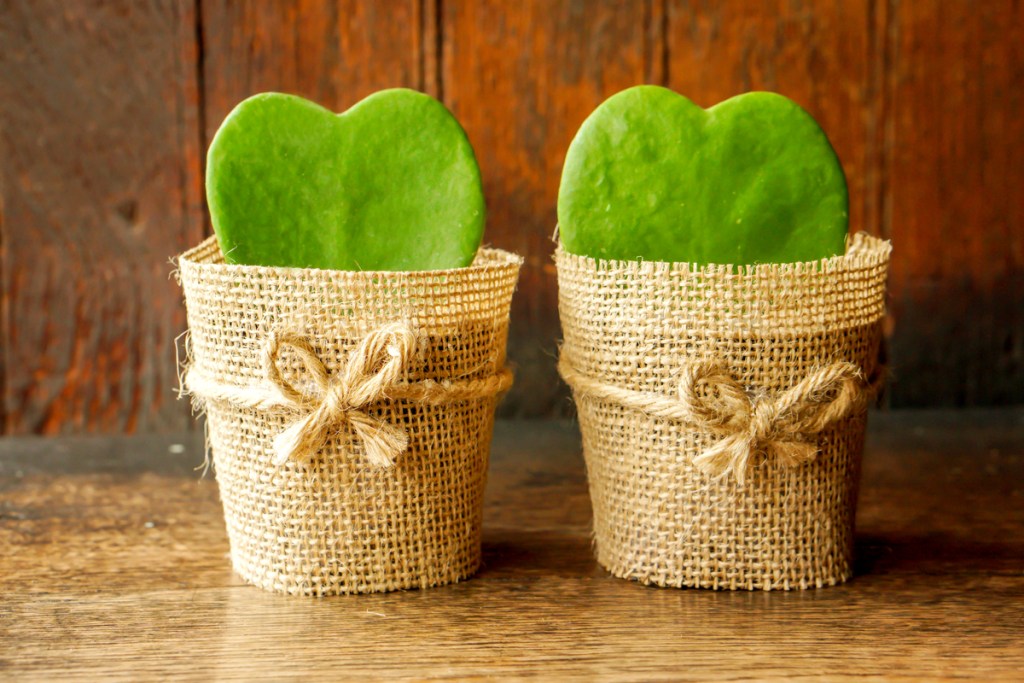The Hoya plant genus includes more than 300 species of beautiful, unique varieties that can grow in homes. Do you like all-green plants? Plants with some white or pink? Plants with interesting textures and distinct shapes? There’s a hoya variety out there for you! Some prove to be more challenging than others, but many of them are perfect plants for beginner gardeners!
The Hoya genus was once part of the Asclepiadaceae family; however, newer taxonomy places the genus in the Apocynaceae family. Although some hoyas can grow outdoors in specific hardiness zones, these plants generally make beautiful additions to any home’s interior.

The Hoya carnosa “compacta”
The Hoya carnosa “compacta” is one of many carnosa varieties available to home gardeners. Commonly known as the Krinkle Kurl plant or Hindu rope plant, this Hoya variety is a vining epiphytic plant native to India. Under the right conditions, it grows star-shaped flowers that have a sweet smell and unique appearance. The leaves make this plant one of the most beautiful to have in a hanging basket or a pot on a shelf because of how the leaves grow clumped together along the vine.
Caring for the Hoya carnosa “compacta”
The Hoya carnosa “compacta” is a slow-growing plant that requires a lot of patience; however, it’s very easy to care for and grow! You want to make sure you keep it out of direct sunlight, as the leaves can easily get burned. That said, keep it in an area with enough light that the plant will have energy to bloom.
Because it’s native to humid climates, the Hoya carnosa “compacta” will appreciate a bit of extra humidity. You can mist the plant every few days if you want, but be cautious of moisture getting trapped in the leaves. A better method would be to either place the plant on a shallow tray of pebbles filled with water to naturally increase humidity or buy a small plant humidifier for the room.
Light needs: Bright, indirect light
Water needs: Water when the soil has mostly dried out
Soil needs: Loose, well-draining potting mix
The Hoya kerrii
Commonly known as the sweetheart hoya or Valentine’s hoya, the Hoya kerrii is a wonderful gift for yourself, friends, and family. Named colloquially for its heart-shaped leaves, the Hoya kerrii is a low-maintenance, unique variety native to Southeast Asia. You’ll mostly see them sold in nurseries as a single five-inch leaf growing upright in a pot.
Caring for the Hoya kerrii
The Hoya kerrii can survive low-light conditions but will be more likely to bloom if kept in an area with plenty of bright, indirect sunlight. You want to make sure that you pot it in a container with good drainage, as that will be an essential part of making sure your plant doesn’t succumb to root rot from too much water trapped in the soil.
Although this variety is easy to care for, getting it to bloom may be a bit tricky. Make sure that it’s kept in a space where the lighting conditions are met and that maintains a regular 60 to 80 degrees Fahrenheit temperature. If your mature Hoya kerrii doesn’t bloom, try either adjusting to brighter light levels or finding a slightly cooler room to move it to at night.
Light needs: Bright, indirect sunlight
Water needs: Drought tolerant; water when soil is dry to touch
Soil needs: Loose, well-draining soil

The Hoya obovata
The Hoya obovata is a beautiful variety that can be a bit more difficult to find, but it’s worth scooping up when you do! Commonly known as the Hoya wax plant, this variety is known for its deep green, oval-shaped leaves with a sporadic silvery design. It grows quickly, which is a stark contrast to other varieties like the Hoya carnosa “compacta.”
Caring for the Hoya obovata
The Hoya obovata doesn’t typically bloom until it’s at least two or three years old, if at all, so it’s most commonly grown for the unique foliage. Because this variety grows quickly, proper fertilization is essential for its health and energy. For full growth, you’ll want to fertilize regularly during the spring and summer months when the plant is actively growing.
If you have the proper conditions and environment and your obovata does bloom, take care not to deadhead the stalk. Unlike other plants, the obovata will bloom again from the same stalk in a couple of years.
Light needs: Bright, indirect light
Water needs: Water thoroughly, allowing the soil to dry out fully between waterings
Soil needs: Loose, well-draining soil
The Hoya curtisii
Known commonly as the Fung wax flower, Hoya aloha, or porcelain flower, the Hoya curtisii is a slow-growing vine variety native to Malaysia, Thailand, and the Philippines. It’s a miniature variety, growing no more than three inches high. Its vining nature allows it to grow about a foot wide, which makes it a perfect plant for hanging baskets in bright areas of your home.
Caring for the Hoya curtisii
Because of the way this plant grows, you can trim and prune the vines to maintain the desired shape as they start to grow and get unruly. The good thing about this variety is that you can use those cuttings to propagate new curtisii! You can easily expand your plant collection or give the cuttings to friends and family as gifts once they’ve rooted and started thriving.
Light needs: Bright, indirect light but can tolerate partial shade
Water needs: Water regularly, allowing the soil to dry out completely between waterings
Soil needs: Loose, well-draining soil
As we mentioned earlier, there are over 300 Hoya species you can grow. These four are just a handful of the ones that are easy for beginners to maintain and care for while dipping their toes in this vast and unique genus.




